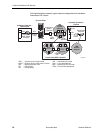
1. About FrameSaver DSL Devices
1-2 December 2002 9700-A2-GB20-20
FrameSaver DSL Features
Based upon the model ordered, or whether the device has been upgraded to
Service Level Verifier (SLV) capability, FrameSaver DSL devices have the
Diagnostic Feature Set or Advanced SLM Feature Set, each providing different
levels of intelligence for monitoring, managing, and reporting performance of the
device.
For features specific to the DSL CSU/DSU or router, see
CSU/DSU-Specific
Features
and
Router-Specific Features
.
CSU/DSU-Specific Features
The following features only apply to the DSL CSU/DSU:
Two Interfaces. Provides two interfaces for traffic:
— Synchronous DTE port for user data
— Ethernet Interface for management data
Upstream Pipelining. Provides pipelining capability into the Wide Area
Network (WAN) for reduced latency, where groups of bytes are transmitted as
soon as they are received, rather than waiting for the entire frame to be
collected before sending.
LMI Protocol Support. Automatically detects and initializes the Local
Management Interface (LMI) protocol type on the user data port.
Router-Specific Features
The following features only apply to the DSL router:
Ethernet Interface. Supports user data and management traffic. An LED is
also provided to view the status of the interface.
In-Band Router Management. Permits the router to be managed via
customer data PVCs and EDLCIs by assigning an IP address for router
management that is different from the IP address generally used for the
network interface.
Inverse ARP for User Data. Provides Inverse ARP (Address Resolution
Protocol) support for user data, as well as management data. The router
responds to Inverse ARP requests, and can acquire the IP address of a
FrameSaver device at the far end of a customer PVC. ARP information is
retained for both customer data and management data.


















